Other
- Page Path
-
- HOME
- TOPICS
- Other
- Topics
-
- Adolescence Medicine (4)
- Allergy (62)
- Cardiology (81)
- Critical Care Medicine (13)
- Developmental and Behavioral Medicine (24)
- Emergency Medicine (5)
- Endocrinology (61)
- Gastroenterology (71)
- General Pediatrics (54)
- Genetics and Metabolism (26)
- Hematology (18)
- Immunology (16)
- Infection (76)
- Neonatology (Perinatology) (125)
- Nephrology (Genitourinary) (54)
- Neurology (96)
- Nutrition (31)
- Oncology (17)
- Neurobehavior (12)
- Pulmonology (34)
- Rheumatology (3)
- Other (43)
- Original Article
- Other
- Impact of thyroid hormones and serum endothelin levels on pediatric asthma control: a case-control study of an Indian population
- Murugaiyan Sathishbabu, Sathiya Ramasamy, Niranjjan Ramachandran, Soundararajan Palanisamy, Arulvijayavani Subramaniam
- Clin Exp Pediatr. 2025;68(10):831-837. Published online September 22, 2025
-

Question: What are the roles of thyroid hormones and endothelin in South Indian children with asthma?
Finding: Thyroid hormone and endothelin levels were significantly elevated in South Indian children with asthma; poorly controlled cases exhibited the highest levels. Elevated thyroid-stimulating hormone and endothelin levels were correlated with asthma severity.
Meaning: Serum endothelin is a potential surrogate marker for asthma severity that could aid the assessment and management of childhood asthma.
- Role of neutrophil elastase in predicting infection among children with chemotherapy-induced febrile neutropenia
- Mahmoud A. El-Hawy, Doaa M. Elian, Mai El-Sayad Abd El-Hamid, Esraa T. Allam, Mariam S. Kandeel, Asmaa A. Mahmoud
- Clin Exp Pediatr. 2025;68(10):801-807. Published online June 10, 2025
-

Question: Can neutrophil elastase (NE) levels predict infection— the primary cause of mortality—among children with hematological malignancies and febrile neutropenia (FN)?
Finding: Elevated levels of NE were found in children with chemotherapy-induced FN and a bacterial infection.
Meaning: Increased NE levels and prolonged FN are important factors associated with mortality risk.
- Review Article
- Other
- Artificial intelligence in pediatric healthcare: current applications, potential, and implementation considerations
- Taejin Park, In-Hee Lee, Seung Wook Lee, Sek Won Kong
- Clin Exp Pediatr. 2025;68(9):641-651. Published online June 25, 2025
-
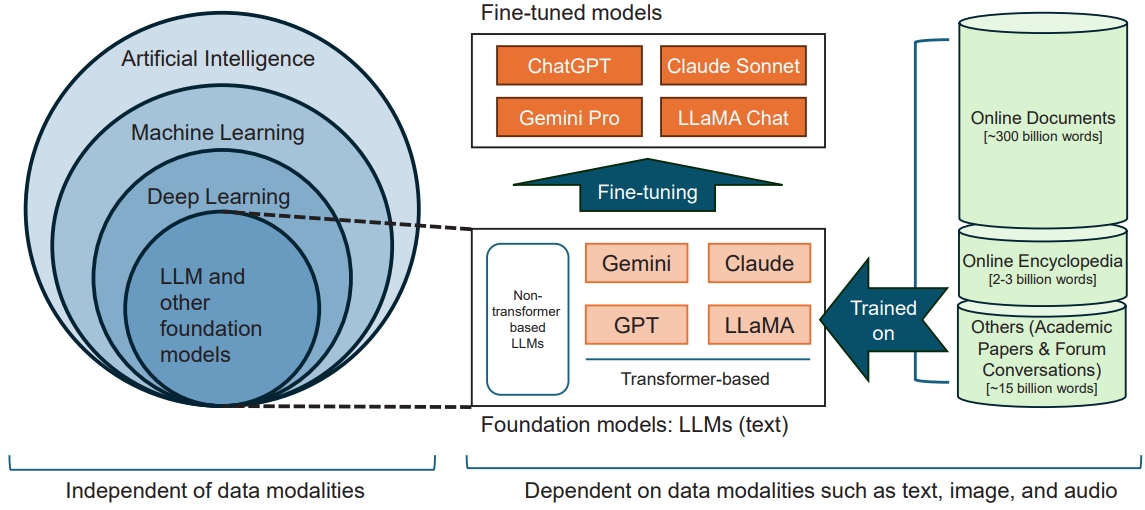
Artificial intelligence (AI) offers potential benefits in pediatric care, but its real-world adoption requires clinician literacy, ethical and legal safeguards, and cautious implementation. Large language models are emerging across healthcare, but their use in pediatric clinical practice remains premature. Thus, the cautious and accountable implementation of AI is crucial to preventing unintended harm and realizing its potential.
- Cost-effectiveness of newborn screening for severe combined immunodeficiency: a systematic review
- Rezwanul Rana, Syed Afroz Keramat, Moin Ahmed
- Clin Exp Pediatr. 2025;68(9):628-640. Published online April 16, 2025
-
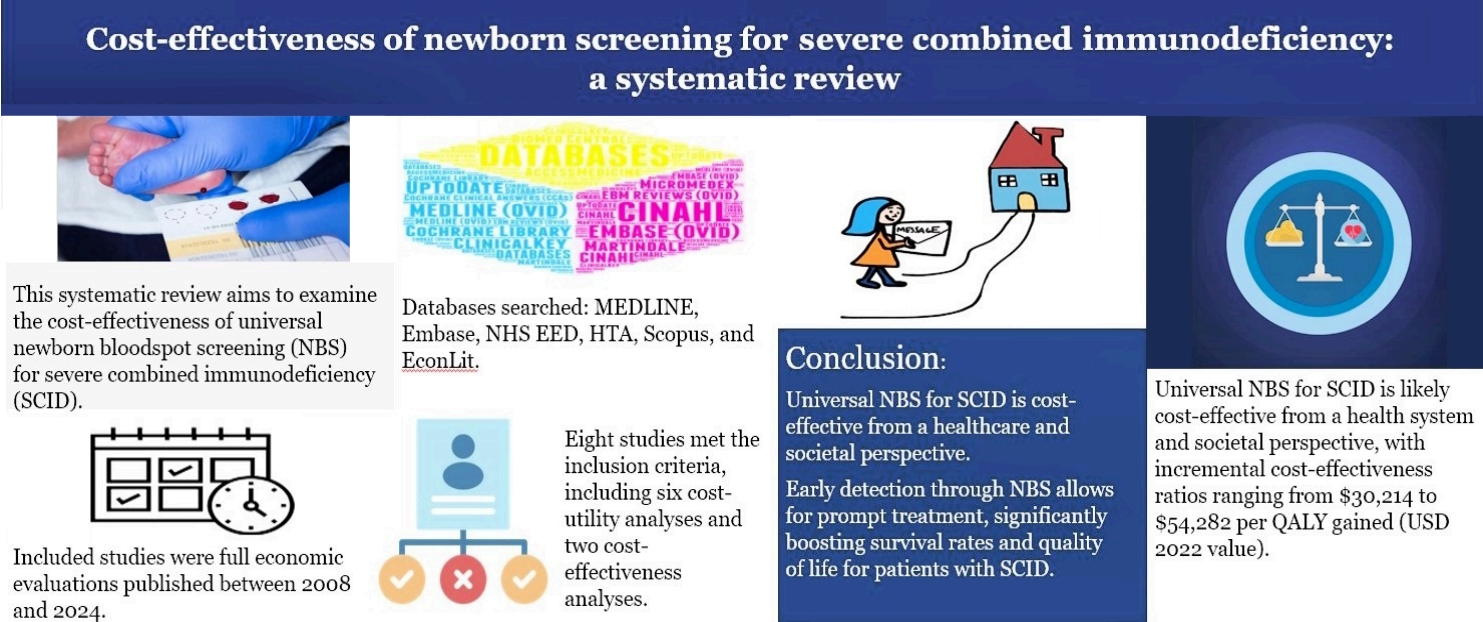
Universal newborn screening for severe combined immunodeficiency (SCID) demonstrates robust cost-effectiveness across diverse high-income healthcare systems, both from healthcare and societal standpoints. Early detection yields substantial savings. While uncertainties persist, impacting precise cost-effectiveness, the overall finding is positive. Future research must prioritize enhanced data collection and statistical rigor to refine our understanding of SCID's economic impact within the Australian context.
- Editorial
- Other
- Beyond the eye: a multidisciplinary perspective on managing pediatric myopia
- Eoi Jong Seo
- Clin Exp Pediatr. 2025;68(8):566-568. Published online July 18, 2025
-
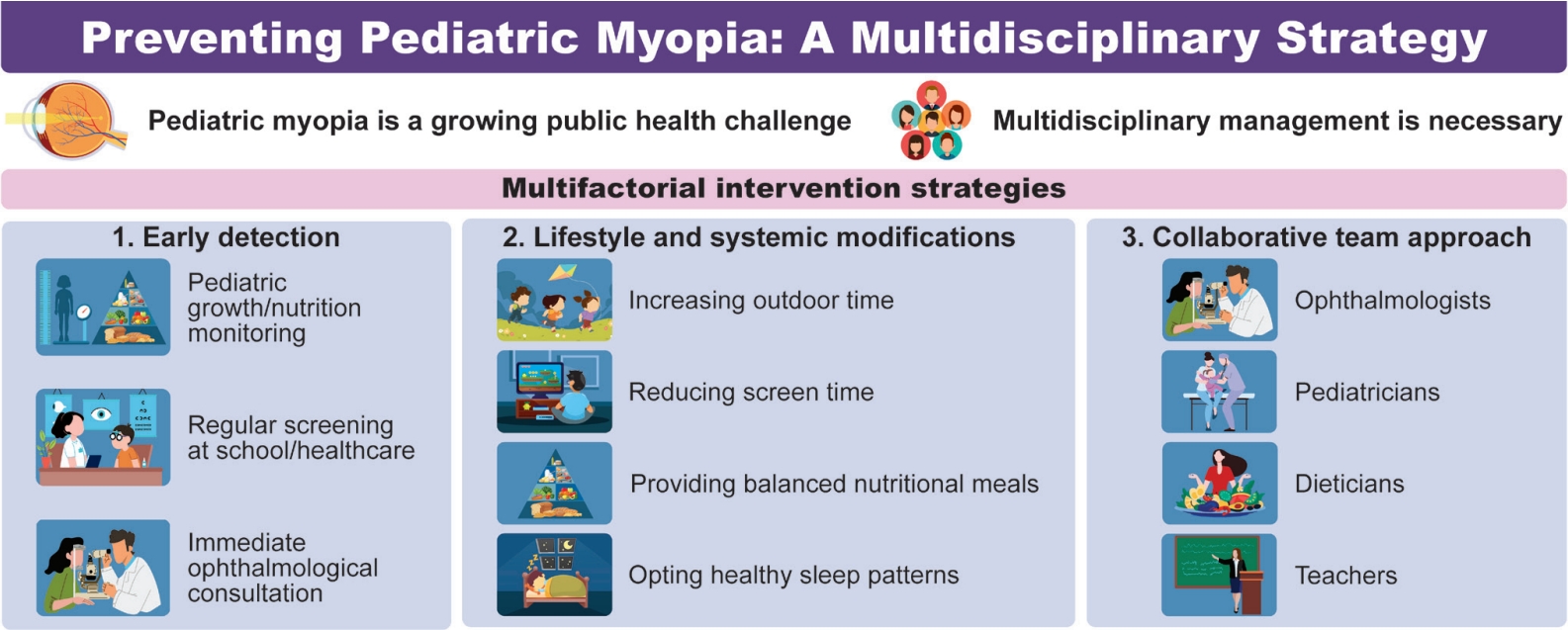
Myopia is a growing global public health concern because of its association with irreversible vision loss such as myopic traction maculopathy, rhegmatogenous retinal detachment, and glaucoma. The effective prevention of myopia in childhood requires a multidisciplinary approach that integrates ophthalmologic care with lifestyle, nutrition, and sleep interventions. Early detection through regular visual screening in schools and primary care settings and timely ophthalmology referrals are critical to preventing high myopia.
- Review Article
- Other
- Myopia: a review of current concepts, association with nonophthalmological conditions, and treatment strategy in children and adolescents
- Yeon Woong Chung
- Clin Exp Pediatr. 2025;68(8):554-565. Published online April 1, 2025
-
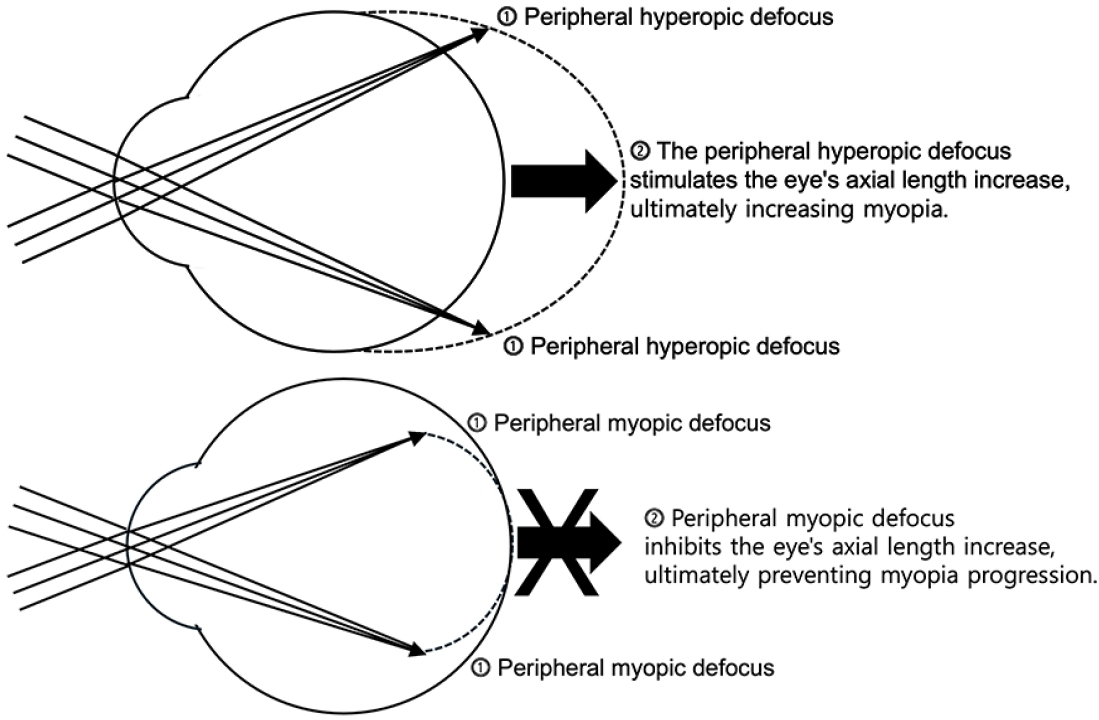
Myopia is a major ophthalmological disorder with increasing prevalence worldwide, particularly in East Asia. Evidence indicates that its development involves complex interactions between genetic and environmental factors. Body stature, sleep patterns, and nutritional status significantly influence the progression of myopia during childhood and adolescence. Its treatment and prevention strategies include optical correction, atropine therapy, increased outdoor activity, decreased near work, and regular retinal monitoring.
- Peripheral nerve sheath tumors in the head and neck in patients with APC gene deletion mutations: a case report and scoping review of the literature
- Koral M. Blunt, Monirah Albathi, Miriam Conces, Tendy Chiang
- Clin Exp Pediatr. 2025;68(6):428-433. Published online January 13, 2025
-

In this report, we describe our experience with a patient with an APC-related genetic syndrome who presented with a rare palatal lesion with characteristics of a schwannoma. We discuss the role of immunohistochemical staining in discerning the differential diagnosis.
- Editorial
- Other
- Further research on impact of microplastics on children's health is essential to protecting future generations
- Jongin Lee, Dong-Wook Lee
- Clin Exp Pediatr. 2025;68(5):359-361. Published online November 13, 2024
-
· The ecological impacts of microplastics have been documented. It was recently recognized that they can directly or indirectly cause diseases in humans.
· There are few established methods for assessing human exposure to microplastics.
· Standardization of exposure assessments and large-scale epidemiological studies are required to explore the human effects of microplastics.
- Perspective
- Other
- Telemedicine in pediatrics: things to consider
- Sandhya J. Kadam, Archana Reddy Bongurala
- Clin Exp Pediatr. 2025;68(4):326-328. Published online February 3, 2025
-

This article highlights the benefits, challenges, and current significance of telemedicine. Future research is needed, primarily to address the challenges of optimizing the implementation of telehealth. To use telemedicine effectively and efficiently for the timely diagnosis and management of patients, an evaluation of current telemedicine practice is needed. Analysis of shortcomings and advantages can help enhance healthcare delivery to pediatric patients, making it more accessible for future use.
- Letter to the Editor
- Other
- Adolescent hypertension and carotid intima-media thickness: significance of submillimetric differences
- Christian Saleh
- Clin Exp Pediatr. 2025;68(1):104-105. Published online November 28, 2024
-
- Review Article
- Other
- Global trends in importance of 24-hour movement behaviors to pediatric health: implications for South Korea
- Eun-Young Lee, Reyana Jayawardena, Seiyeong Park, Justin Y Jeon, Yeon-Soo Kim, Mark S. Tremblay
- Clin Exp Pediatr. 2025;68(1):16-29. Published online November 11, 2024
-

· The 24-hour movement behavior paradigm provides an important framework for future pediatric health promotion efforts.
· Policy priorities should include advancing surveillance and monitoring assessments related to 24-hour movement behaviors, evaluating their implementation in school and government policies, and building preparedness for future pandemics and natural disasters, including climate change, by promoting healthy 24-hour movement behaviors.
· Future research should advocate for the promotion of 24- hour movement behaviors.
- Microplastic and human health with focus on pediatric well-being: a comprehensive review and call for future studies
- Rogers Wainkwa Chia, Ntegang Venant Atem, Jin-Yong Lee, Jihye Cha
- Clin Exp Pediatr. 2025;68(1):1-15. Published online November 6, 2024
-

· Milk and formula are common sources of microplastic in infants.
· Water and air are the most common sources of microplastic pollution from infancy to adolescence.
· Microplastic use by children of all ages can cause cell damage and affect their health.
· Microplastics present in children can be quantified using a stereomicroscope and characterized using micro- Fourier transform infrared spectroscopy.
- Original Article
- Other
- Balance assessment with decreased base of support for children with disabilities
- Guilherme M. Cesar, Madison Giebler, Thad W. Buster, Judith M. Burnfield
- Clin Exp Pediatr. 2024;67(12):718-724. Published online November 11, 2024
-

Question: Can a balance task with narrowed base of support indicate overall functional balance control in children with disabilities?
Finding: While single-limb standing could explain overall balance control for children with disabilities, it was unrelated with balance control for typically developing children.
Meaning: One balance task with narrowed base of support can be used as practical assessment of balance abilities for children with disabilities when allocated session time is of concern.
- Review Article
- Other
- Use of virtual reality in children in a broad range of medical settings: a systematic narrative review of recent meta-analyses
- Emily Antonovics, Grammatina Boitsios, Thomas Saliba
- Clin Exp Pediatr. 2024;67(6):274-282. Published online May 21, 2024
-

· Virtual reality (VR) is becoming increasingly common for entertainment and in medical settings.
· VR is useful for treating children with cerebral palsy.
· VR can help with attention deficit/hyperactivity disorder symptoms.
· VR can decrease pain perception in children undergoing burn wound care.
· VR can reduce preoperative anxiety.
· VR can reduce fear and pain during needle-involving procedures.
- Children’s health affected by parent’s behavioral characteristics: a review
- Sung Eun Kim, Jongin Lee
- Clin Exp Pediatr. 2024;67(5):232-239. Published online August 21, 2023
-

· Parents’ occupational hazards, long working hours, and smoking behaviors should be modified adequately to minimize adverse health effects on their children.
· As of 2023, several diseases from fetal exposure to occupational hazards can be compensated with Industrial Accident Compensation Insurance in South Korea.
· A directed acyclic graph is recommended for medical research to control the effects of parents’ behaviors on children’s health.
- Acetaminophen causes neurodevelopmental injury in susceptible babies and children: no valid rationale for controversy
- Lisa Zhao, John P. Jones, Lauren G. Anderson, Zacharoula Konsoula, Cynthia D. Nevison, Kathryn J. Reissner, William Parker
- Clin Exp Pediatr. 2024;67(3):126-139. Published online June 14, 2023
-
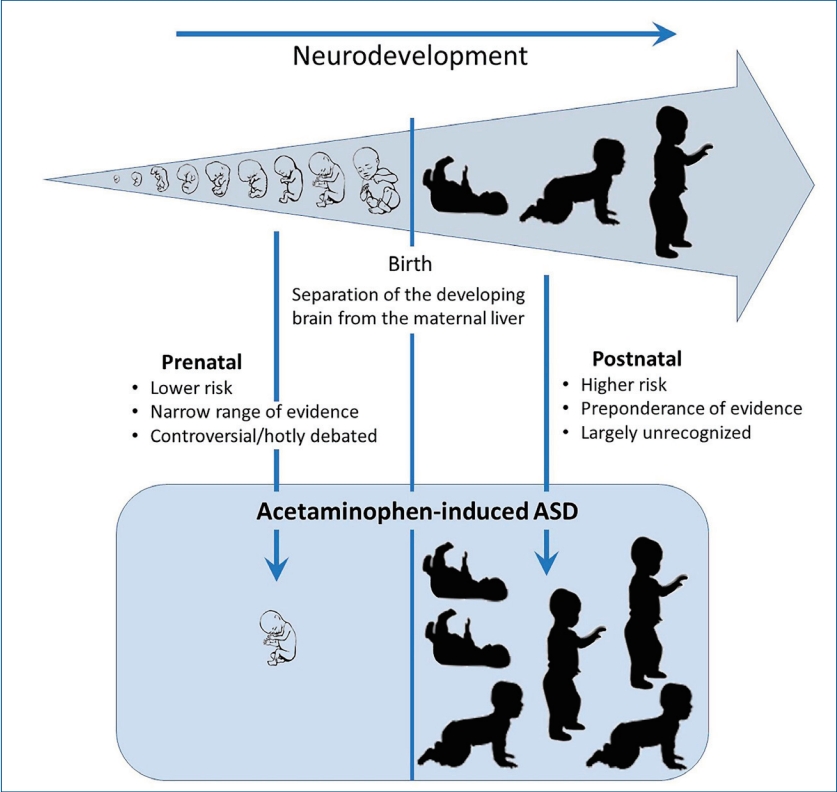
Despite worldwide acceptance of acetaminophen (paracetamol) in pediatric medicine, careful examination reveals no valid objections to the conclusion that early exposure to acetaminophen causes neurodevelopmental injury in susceptible babies and children. Nevertheless, debate that early exposure to acetaminophen causes neurodevelopmental injury has centered around the prenatal period, evidence of which is relatively limited compared to that in the postnatal period, which is the time of greatest absolute and relative risk.
- MicroRNAs as novel biomarkers for the diagnosis and treatment of pediatric diseases
- Hwal Rim Jeong, Il Tae Hwang
- Clin Exp Pediatr. 2024;67(3):119-125. Published online May 24, 2023
-

MicroRNAs (miRNAs) are small noncoding RNAs that regulate gene expression post transcriptionally, and MiRNA expression levels vary with developmental stages. MiRNAs play an important role in several biological processes in children, including growth, neuro-development, inflammation, and tumor formation. Research on miRNAs may uncover the molecular mechanisms underlying various pediatric diseases, leading to the development of novel biomarkers that aid in the diagnosis, treatment, and prognosis of these diseases.
- Original Article
- Other
- Virtual, augmented, and mixed reality: potential clinical and training applications in pediatrics
- Suyoung Yoo, Meong Hi Son
- Clin Exp Pediatr. 2024;67(2):92-103. Published online May 24, 2023
-

· Review of articles that investigated the applications of virtual, augmented, or mixed reality in pediatric clinical settings and in the training of pediatric medical professionals was conducted.
· A total of 89 studies were retrieved, with 36 randomized controlled trials.
· In most studies, intervention using the novel technology was at least as effective or more effective than the traditional method.
· Use of virtual, augmented, and mixed reality has potential in pediatrics.
- Review Article
- Other
- Hearing loss in neonates and infants
- Goun Choe, Su-Kyoung Park, Bong Jik Kim
- Clin Exp Pediatr. 2023;66(9):369-376. Published online January 9, 2023
-

· Congenital hearing loss is common, with an approximate incidence of 1.5 per 1,000 newborns and affecting 1.2%–11% of preterm and 1.6%–13.7% of neonatal intensive care unit neonates.
· Etiologies vary, and up to 80% of cases are genetic.
· Newborn hearing screenings follow the 1-3-6 rule, and babies at high risk of hearing loss should be referred to otolaryngology for early detection and timely intervention.
- Clinical Note
- Other
- Novel PTRH2 gene variant causing IMNEPD (infantile-onset multisystem neurologic, endocrine, and pancreatic disease) in 2 Saudi siblings
- Dalal K. Bubshait
- Clin Exp Pediatr. 2023;66(5):223-225. Published online March 23, 2023
-

- Perspective
- Other
- New public-centered child protection system in Korea
- We Sun Shim
- Clin Exp Pediatr. 2023;66(5):179-181. Published online April 18, 2023
-
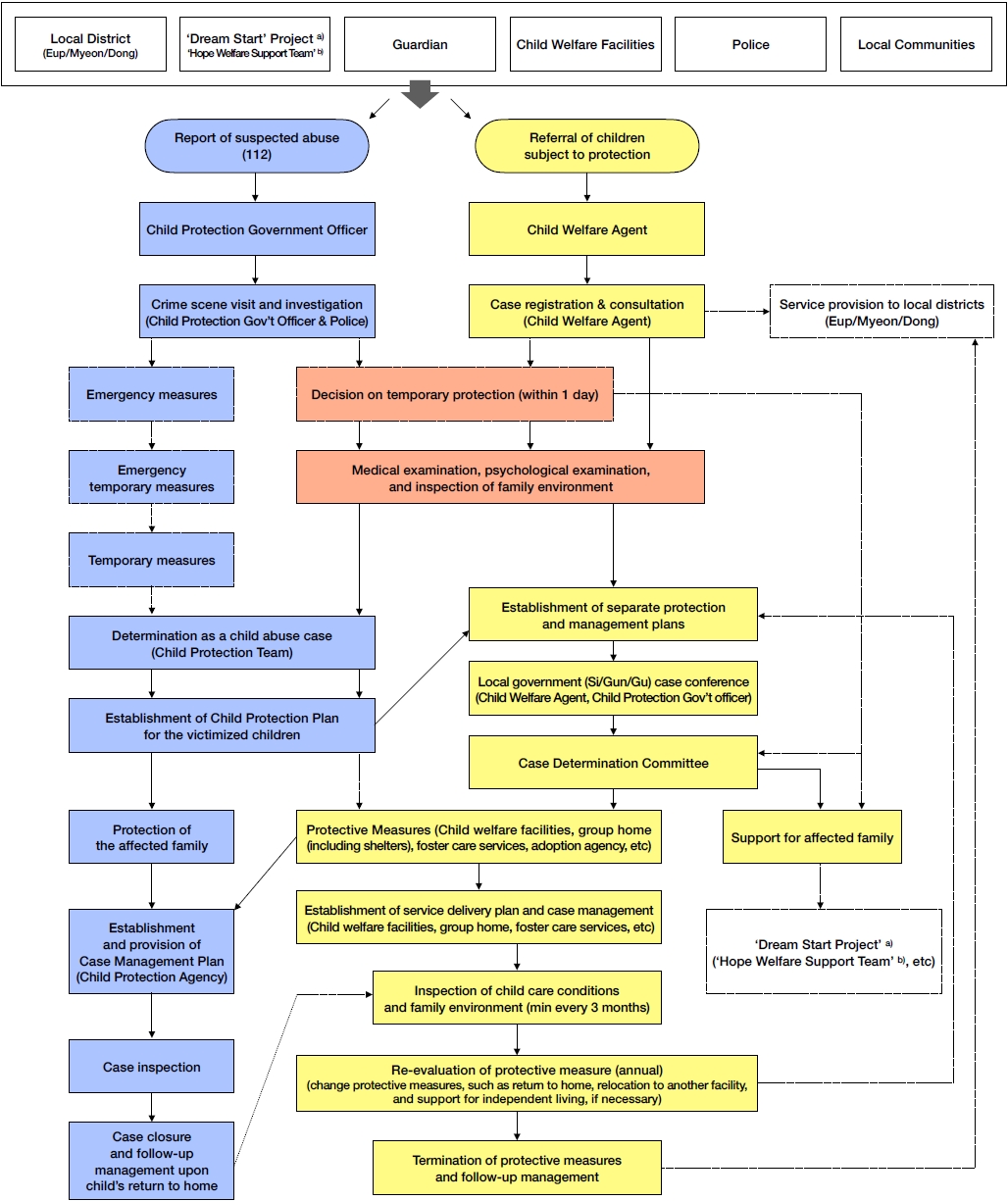
Korea’s child abuse response system was transformed under policy change in April 2020, from what was previously operated on a private-centered basis to a focus on the public sector with expanded role of local governments. Promising outcomes are expected with new system as greater governmental intervention will effectively protect at-risk children with acceleration in institutional collaboration and expertise in information management and administration.
- Editorial
- Other
- Advancing pediatric health: the multifaceted scope of Clinical and Experimental Pediatrics
- Jin Hee Oh, Man Yong Han
- Clin Exp Pediatr. 2023;66(4):171-172. Published online March 29, 2023
-
Clinical and Experimental Pediatrics (CEP) is a journal that specializes in pediatric research topics. It covers a wide range of research areas, including basic research, translational research, and research related to improving pediatric health and diseases. CEP also focuses on the coordination of societal structures and processes that orchestrate pediatric health and disease throughout society, and the parallel relationship between regional characteristics and globalization. The journal intends to continue promoting pediatric health through relentless efforts and the discovery of new research areas.
- Three-dimensional printing technolgy in orthopedic oncology
- Yongsung Kim
- Clin Exp Pediatr. 2022;65(10):496-497. Published online May 11, 2022
-
Orthopedic oncology is one of the most active fields in applying 3-dimensional printing technology from preoperative planning to intraoperative procedures such as accurate resection of tumors and reconstruction of huge bone defects.
- Original Article
- Other
- Plastic bottle feeding produces changes in biochemical parameters in human infants – A pilot study
- Mahendra K. Pant, Abul. H. Ahmad, Manisha Naithani, Jayanti Pant
- Clin Exp Pediatr. 2022;65(9):459-465. Published online May 19, 2022
-
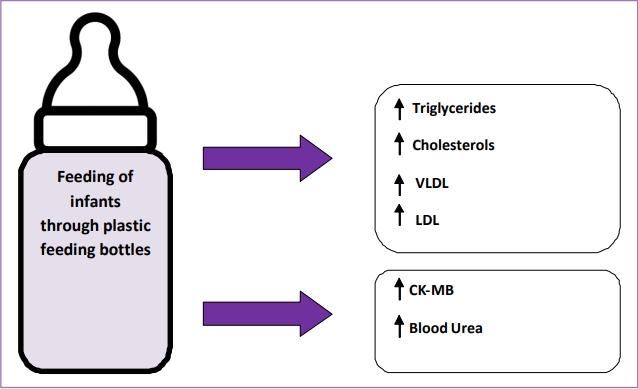
Question: Plastic feeding bottles are used commonly to feed infants who cannot be breastfeed. Does plastic bottle feeding produce biochemical changes in infants?
Finding: The plastic bottles leach out endocrine disruptors and affects bodily functions in terms of biochemical alterations like increased blood urea, raised creatine-kinase–MB levels, and altered lipid profile in infants exposed to bottle feeding.
Meaning: Plastic bottles feeding alters bodily functions in infants.
- Review Article
- Other
- Epidemiology of pediatric fractures before versus during the coronavirus disease 2019 pandemic
- Chi Hoon Oh, Siyeong Yoon, Kyung Rae Ko, Young Woo Kwon, Kyeong Mi Kim, Hyun Seo Park, Hogyeong Kang, Inseok Jang, Soonchul Lee
- Clin Exp Pediatr. 2022;65(7):330-336. Published online June 3, 2022
-

∙ The novel coronavirus disease 2019 (COVID-19) was first reported in December 2019 as a cluster outbreak in Wuhan, since then, national lockdowns have included school closures, stay-at-home orders.
∙ The characteristics of adolescent fractures were often related to physical activity such as sports-related injury.
∙ During the COVID-19 pandemic, both in the East and the West, the incidence of fractures in children and adolescents is showing a decreasing trend worldwide.
∙ Fractures in children and adolescents were significantly reduced in the proportion of relatively low-energy damage, and the incidence of fractures in adolescents with greater activity compared to children was reduced.
∙ If COVID-19 pandemic ends, normal academic and sports activities increase due to the easing of lockdown policies, the number of trauma patients related to increased activity may increase rapidly, and clinics should prepare for this change.
- Original Article
- Other
- Risk factors and screening timing for developmental dysplasia of the hip in preterm infants
- Ga Won Jeon, Hye Jung Choo, Yong Uk Kwon
- Clin Exp Pediatr. 2022;65(5):262-268. Published online November 5, 2021
-

Question: When is the best screening timing and what is the risk factor for developmental dysplasia of the hip (DDH) in preterm infants?
Finding: Ultrasonography performed earlier than 38 weeks of postmenstrual age caused unnecessary subsequent ultrasonography. DDH did not occur predominantly on the left side or in breech infants.
Meaning: The screening timing, etiology, and risk factors for DDH in preterm infants are somewhat different from those in term infants.
- Review Article
- Other
- Knowledge-guided artificial intelligence technologies for decoding complex multiomics interactions in cells
- Dohoon Lee, Sun Kim
- Clin Exp Pediatr. 2022;65(5):239-249. Published online November 26, 2021
-

· The need for data-driven modeling of multiomics interactions was recently highlighted.
· Many artificial intelligence-driven models have been developed, but only a few have incorporated biological domain knowledge within model architectures or training procedures.
· Here we provide a comprehensive review of deep learning models to decipher complex multiomics interactions regarding the biological guidance imposed upon them to facilitate further development of biological knowledge-guided deep learning models.
- Letter to the Editor
- Other
- Changes in air pollution and childhood respiratory viral infections in Korea post-COVID-19 outbreak
- Hyung Kyu Park, Jung Yeon Shim
- Clin Exp Pediatr. 2022;65(4):211-213. Published online February 17, 2022
-

- Evaluation of simulation-based ultrasound course for pediatricians: a starting point for future training curriculum
- Chon In Kuok, Avis Siu Ha Leung, Jonan Chun Yin Lee, Winnie Kwai Yu Chan
- Clin Exp Pediatr. 2022;65(1):53-55. Published online July 28, 2021
-
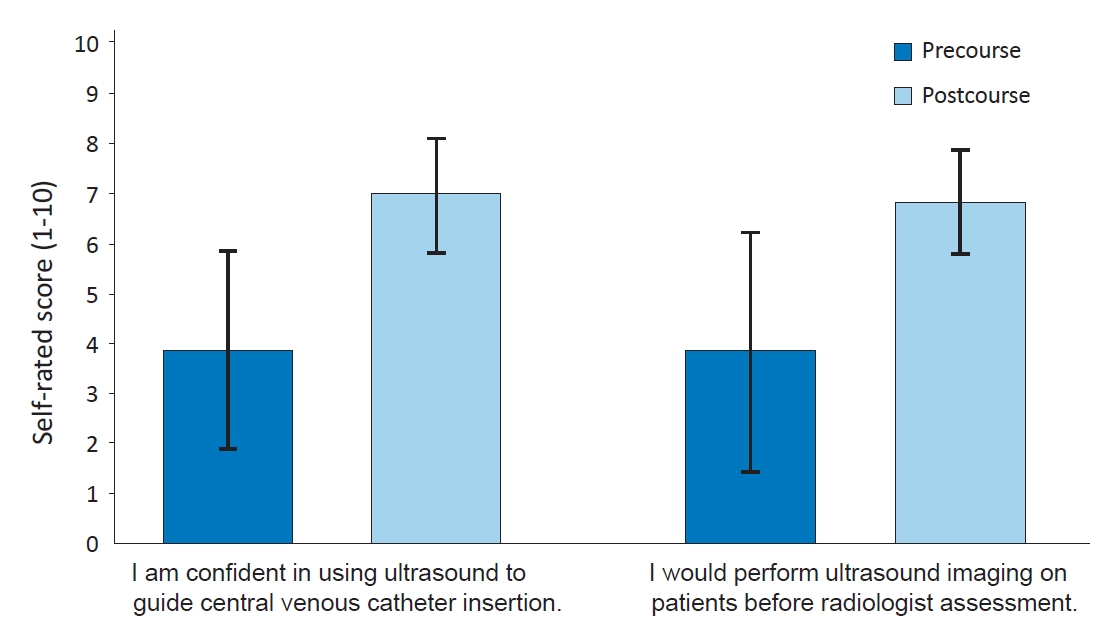
Question: Simulation-based ultrasound training is becoming more popular. Is there a role for pediatricians in such training programs?
Finding: Our program received promising feedback from its participants. Self-rated confidence in image interpretation and ultrasound-guided catheter insertion improved after the simulation. Participants reported a higher preference for performing ultrasound scans before radiologist assessment.
Meaning: Ultrasound training can be considered as part of the pediatric training curriculum in the future.
- Original Article
- Other
- Spatial modeling of mortality from acute lower respiratory infections in children under 5 years of age in 2000–2017: a global study
- Ali Almasi, Sohyla Reshadat, Alireza Zangeneh, Mehdi Khezeli, Raziyeh Teimouri, Samira Rahimi Naderi, Shahram Saeidi
- Clin Exp Pediatr. 2021;64(12):632-641. Published online March 19, 2021
-
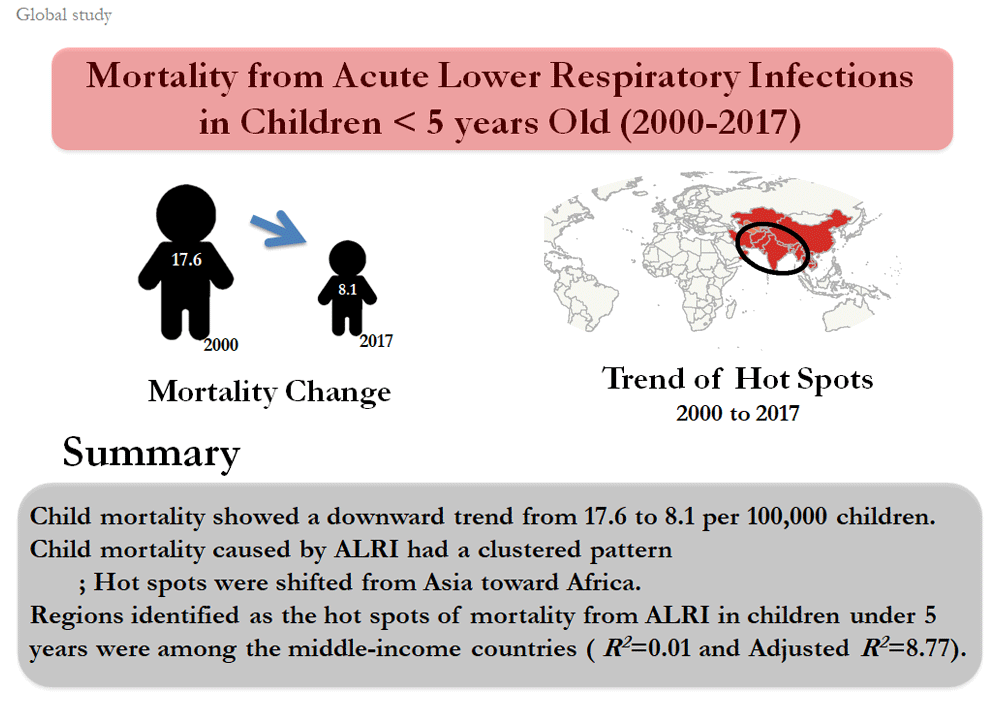
Question: We assessed the spatial modeling of mortality from acute lower respiratory infections in children under 5 years old during 2000–2017 using a global data.
Finding: The total number of child deaths during the study period decreased, while the number of hot spots increased among countries.
Meaning: Hot spots were concentrated in Asia in 2000 but shifted toward African countries by 2017. A cold spot formed in Europe over the study period.
-

-
-
6.02024CiteScore98th percentilePowered by
-
Impact Factor3.6
-
- TOPICS
- ARTICLE CATEGORY
- Editorial Office
-
Korean Pediatric Society
#1606 Seocho World Officetel, 19 Seoun-ro, Seocho-ku, Seoul 06732, Korea
Tel: +82-2-3473-7306 Fax: +82-2-3473-7307 E-mail: office@e-cep.org
Clinical and Experimental Pediatrics is an open access journal. All articles are distributed under the terms of the Creative Commons Attribution NonCommercial License (http://creativecommons.org/licenses/by-nc/4.0/)
Copyright © 2025 by Korean Pediatric Society.











